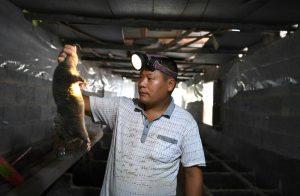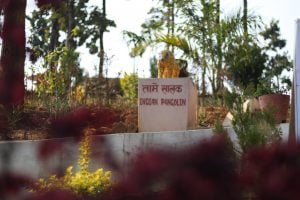Just one month before the Mirpur earthquake of 2019, Mohammed Altaf had married off his daughter, exhausting all his savings. The earthquake caught him at his most financially vulnerable. Altaf is a salesman at a plastic furniture shop in Jatlan, Mirpur, and earns just enough to cover the expenses for a modest existence.
“Neighbours rescued my family, but my house was completely destroyed,” he said. He added that while NGOs had provided them food and a tent to live in, “the government has not provided us even a single penny till today.”
This earthquake, with its epicentre in Pakistani administered areas, took the lives of around 40 people and injured more than 850. The tremors were felt in the Indian regions of Punjab, Kashmir and New Delhi as well. It was another reminder that South Asia, and its people, are very vulnerable to seismic activity.
This is true of both the eastern and western Himalayas. The 2015 Nepal earthquake is a haunting testimony to this fact.
“I saw buildings fall down like nothing. The ironic thing was that engineering colleges fell down, institutions which are supposed to teach students to build good earthquake resistant homes.”Ashish Mishra
See: Stories of survival after the Nepal quake
With a magnitude of 7.8 on the Richter scale, it caused immense destruction to life and property. The death toll reached 9,000 people and nearly 22,000 individuals were injured.
Ashish Mishra was one of the people who lived through it. “I saw buildings fall down like nothing. The ironic thing was that engineering colleges fell down, institutions which are supposed to teach students to build good earthquake resistant homes,” he said.
While Ashish was lucky to survive, thousands perished. It had an enormous fallout in neighbouring countries as well with loss of lives in India (78), China (27) and Bangladesh(4).
Although minor seismic activities are common in South Asia, this was a major one. It shows how natural disasters like earthquakes and floods do not respect manmade boundaries. Any major calamity in one country is likely to effect neighbouring ones as well.
Is South Asia prepared?
R Bilham and N Ambraseys state in a 2005 report titled “Apparent Himalayan slip deficit from the summation of seismic moments for Himalayan earthquakes,1500–2000,” that the Indian plate is moving towards the Eurasian plate by 16 -18 millimetres per year. This movement may cause the release of stress and result in future events of earthquakes.
Afghanistan is a recurrent spot in earthquake occurrences in South Asia. In India, the entire northern stretch comes under mostly seismic zones 4 and 5 with the capital Delhi, coming under zone 4, considered a high damage risk zone.
Given the low development indicators of most South Asian countries, these earthquakes not only cost lives but also have a disproportionate impact on the economies of these countries. The Center for Disaster Management and Risk Reduction Technology reported that the direct loss to the Nepali economy was approximately USD 3 billion, while indirect losses were up to USD 10 billion. Nepal’s GDP in 2018 was just over USD 27 billion.
Disasters of such huge magnitudes compel governments to act but those actions seem to be for a limited period of time only. Preparedness for natural disasters hardly comes up as an important issue for any of these countries. This is despite numerous warnings by seismologists that the next big earthquake could be in South Asia.
Why is it difficult to get these countries together?
A geologist from Nepal, speaking on the condition of anonymity, said “It will only work through data and resource sharing among the 8 member countries but Afghanistan and Pakistan aren’t always on good terms. Pakistan and India always view each other with suspicion. Nepal was a neutral player but the Kalapani dam issue and other activities by India have really soured public opinion.”
He further added, “Sri Lanka and Maldives are detached countries and Bhutan is sort of isolated, in its own world. So, the chances of such a body ever forming, and – if formed – then working, are very slim.”
Maqsood Hussain Soomro, Assistant Director (Operations) at Provincial Disaster Management Authority Sindh, Pakistan said, “the authorities across the border do coordinate and share information about early responses to disasters but there is no forum for it.”
In India, a top seismologist based in Hyderabad said, “A lot of complexities have to be considered when we look at this. Say for example, Pakistan would not want to share its seismological data with India and vice versa because of various security reasons.” He further added that countries have to be on the same page to allow anything like this.
Could SAARC play a role?
In other regions transboundary cooperation has been successful. Europe has its own European Seismological Commission (ESC) which places disaster prevention and the reduction of risks at the centre of its disaster risk management. It helps EU member states to develop policies to better prevent, prepare for and respond to disasters. The Association of Southeast Asian Nations (ASEAN) has the ASEAN Earthquake Information Centre.
In South Asia, though, there is no transnational cooperation on issues of seismology. One organisation that could facilitate this is in South Asia is the South Asian Association for Regional Cooperation (SAARC). It was formed to enhance socio-economic cooperation in South Asia, and thus has the mandate to help create a multilateral centre for seismology. The entire region can reap benefits from such a centre as it would help in the quick sharing of data between these countries. It would also help to create a pool of the best seismologists and provide them with adequate funds to carry out extensive indigenous research instead of relying solely on reports of foreign experts and agencies.
If successful, it can even impart training courses on par with the ESC emerging as a powerful centre imparting knowledge, research and creating awareness about earthquake measures that in the current scenario seems negligible among the populations of these countries.
Interestingly, an organisation did exist till 2015 by the name of SAARC Meteorological Research Centre (SMRC) but it was closed, along with five other regional centres due to lack of funds. This centre had published 150 scientific reports and articles in local as well as international journals. A new regional centre was formed by the merger of all these entities called “SAARC Disaster Management Centre (SDMC).
Wendy Bohon, a geologist and Science Communications Specialist at the Incorporated Research Institutions for Seismology (IRIS) a consortium of over 120 US universities, explained how transnational organisations help in better understanding of earthquakes and previously unknown faults.
“Increased seismic monitoring and data sharing allows us to detect and locate these earthquakes more accurately. This helps scientists determine potential earthquake threats from previously unknown faults. Earthquakes can cause tremendous damage and loss of life hence it’s critical for scientists and governments to work to prevent loss of lives and property,” Bohon said.
With the lives of millions at stake, governments in South Asia must recognize this impending danger, and figure out a way to act in cooperation. Even if it is only out of sheer self-interest they must be able to discuss science, despite the hostilities between them.
Adnan Khan, Aafreen Khan and Verda Subzwari are students of MA (Convergent Journalism) at Jamia Millia Islamia. Inputs from Asim Muhammad Ameen and Syed Osama Ali from Pakistan
![<p>The 2014 earthquake in Nepal was the worst since 1934 [image by Laxmi Prasad Ngakhusi / UNDP Nepal]</p>](https://www.thethirdpole.net/content/uploads/2020/02/UNDP-NP-earthquake-Kathmandu-2015-300x200.jpg)

![Snow and rain in April 2016 was disastrous for Gilgit-Baltistan [image courtesy Pamir Times]](https://www.thethirdpole.net/content/uploads/2016/04/snow-picture-Credit-to-PAMIR-Times-300x169.jpg)

